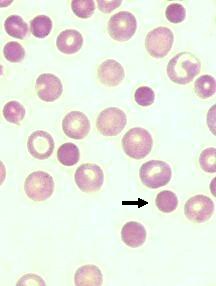
Wright's Stain, 500x
Spherocytes (black arrow) are red blood cells which are smaller and denser than their normal counterparts. Their increased density stems from the loss of the red blood cell's characteristic biconcave shape. When spherocytes form, it is especially evident in canine blood where the erythrocyte's biconcavity tends to be more pronounced than in other species. In the dog, biconcavity is often readily observed as a lighter area in the erythrocyte's center. In addition to being denser, the spherocyte is also smaller because of the partial loss of its membrane, but not its cellular content. Presumably, this occurs during partial phagocytosis stimulated by antibodies on the cell surface. Hence, the observation of spherocytes in a blood smear is most often linked to immune-mediated hemolytic anemia. It is important to note that spherocytes may be difficult to identify (especially in species whose erythrocytes possess a less pronounced biconcave structure). In order to identify them, it is important to compare them with normal mature red blood cells. Furthermore, spherocytes may not always be noted in immune-mediated hemolytic anemia.
Note the normal red blood cells both immediately above and to the right of the spherocyte in this microphotograph.